
by PRIDE Reading Program Admin | Apr 21, 2015 | A PRIDE Post, Writing Disorder
Dysgraphia is a type of learning disability in which an individual has difficulties putting thoughts to words when writing and the overall writing ability falls substantially below what is normally expected. Children with this sort of difficulty will find any sort of written activity to be a painstaking process and may have great difficulty constructing sentences and paragraphs in a grammatical or logical format and struggle tremendously with note- taking.
Dysgraphia Help – Some common symptoms of dysgraphia are:
- Cramped fingers when grasping pencil or pen
- Unusual pencil grip
- Frequent cross-outs or erasures in written work
- Inconsistent writing, mixture of upper and lower case letters, printed and cursive, variations in letter sizes and irregular formation of letters and slants
- Difficulties writing on the lines or within margins
- Very slow writing
- Easily fatigued while writing
- Illegible handwriting
- Many reversals of letters and numbers
- Some words are written backwards
- Letters might be out of order
- Difficulties organizing thoughts on paper
- Multiple spelling mistakes
- Errors in grammar and punctuation
- Sentences lack cohesion
Here are some examples of how to help a child with Dysgraphia overcome some of their difficulties:
In Preschool or Kindergarten:
- Encourage the correct pencil grip, posture and paper hold while writing. Try to reinforce this often before a habit is formed. Using a rubber band can help keep the correct finger grasp in place.
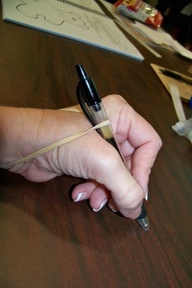
- Use different pens and pencils that are a comfortable fit for your little one. Sometimes-fat markers on the white board work best for little fingers.
- Use paper with raised lines to help guide staying within the lines.
A young child with Dysgraphia will need to practice letter formation using multisensory writing strategies to improve motor memory. They will need to move, touch, feel and manipulate real objects as they learn the habits and skills essential for writing. Some examples are:
1. Have the child first write the letter in the air with two fingers. Then they can trace over a yellow highlighted letter. Finally, they can write the modeled and traced letter independently on a whiteboard or piece of paper.
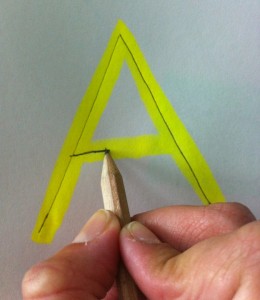
2. Use the wet-dry-try method. Children write the letter on a chalkboard with a wet sponge using the correct letter formation. Afterwards, they dry the letter with a dry sponge using the correct formation. Then, they rewrite the letter correctly again with a piece of chalk.
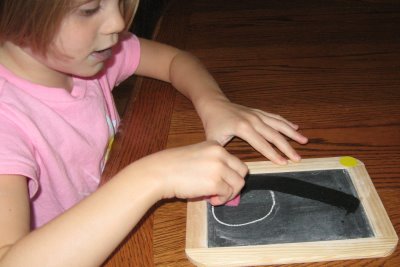
3. Build letters out of clay or play dough

4. Use shaving cream to write the letters
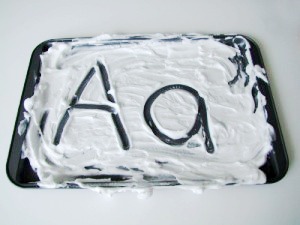
5. Trace letters on a piece of sandpaper or a bumpy surface
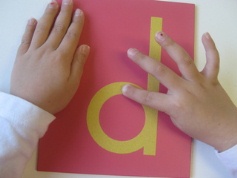
6. Speak out loud while writing the letters. For example, speaking through motor sequences, such as “b” is “first comes the bat, then comes the ball.”

In Elementary School:
- Introduce a keyboarding program on the computer or tablet as soon as possible. Typing can make it easier for a child with Dysgraphia to write by alleviating the frustration of forming the letters.
- Give the child extra time to complete writing activities.
- Have the child proofread the work later in the day. It is easier to see mistakes after taking a break.
- Help the child create a checklist of editing their own work. This can include spelling, neatness, grammar, syntax, written expression.
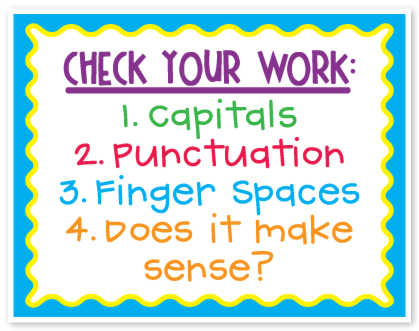
- Encourage the use of a spell checker
- Students can first verbally talk into a recorder to express their ideas and then follow up by writing them afterwards.
- Create a well-organized plan that breaks writing assignments into small tasks.
- Use games and movement activities to reinforce spelling and sight words. Some examples are:
- Bounce a Ball – bounce a ball as you spell words. 1 bounce per letter.
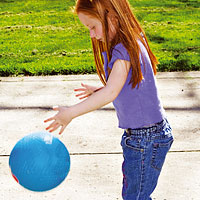
- Cheerleader Chant – Give me an S, give me a P, give me an E, give me an L, give me a L, give me another L – what’s that spell? SPELL!
- Jumping Jacks – Instead of writing the words, the student can spell them aloud while doing jumping jacks.

A student with Dysgraphia will benefit from being explicitly taught the steps of the writing process. Just as these students were taught to read in a step-by-step process, they will also need explicit and direct instruction in writing.
Students who struggle with Dysgraphia will need to explicitly be taught different types of writing such as expository and personal essays, short stories, poems, etc. This means that a teacher will need to provide these students with specific ideas and instructions. As part of these writing lessons, students will need to be given “visualization” strategies and mnemonics, which are a fun and easy strategy for remembering essential steps in the writing process.
Children struggling with Dysgraphia will need a structured, sequential, systematic, cumulative and multisensory writing program to help them build lasting memories. This might require more one-on-one sessions with a trained writing teacher, parent or tutor.
Learn more about the New PRIDE Reading Program

__________________________________________________________________________________________________________
Karina Richland, M.A. is the Founder of PRIDE Learning Centers, located in Los Angeles and Orange County. Ms. Richland is a certified reading and learning disability specialist. Ms. Richland speaks frequently to parents, teachers, and professionals on learning differences, and writes for several journals and publications. You can visit the PRIDE Learning Center website at: www.pridelearningcenter.com

by PRIDE Reading Program Admin | Apr 19, 2015 | A PRIDE Post, Reading Comprehension
Reading comprehension is not an easy activity. In fact, it can be really hard work! Did you know that without proper interventions, 74% of the children who are poor readers in third grade remain poor readers in the ninth grade? Reading comprehension impacts all subjects in school including literature, science, social studies and even math. For students to do well academically, they must be able to comprehend the material they are reading. Reading research shows that good readers:
- are active readers and have goals in mind as they are working through a text.
- make predictions about what is to come
- look over the structure of the text before they read to determine which sections are the most relevant to their reading goals.
- read selectively, determining which sections to read carefully , which to read quickly, which not to read, and so on.
- construct, revise, and question the meanings they make as they read.
- try to determine meaning of unfamiliar words and concepts in the text.
- read various types of texts differently. In narrative, a good reader pays close attention to the setting and characters but in expository text, a good reader frequently summarizes what they have read.
- Feel a sense of satisfaction and productivity after reading a text
Research according to the National Reading Panel 2000, has proven that explicit and direct instruction is the core of good reading comprehension. Children need to learn to use comprehension strategies before, during and after they read. Here are a few research-based strategies that help students become active readers:
Predictions
Students are encouraged to generate expectations about what characters might do, or how the plot might evolve, based on their own experiences in similar situations. Making a prediction activates the student’s prior knowledge and therefore provides a foundation for any new information they will learn while reading. This prior knowledge facilitates their understanding of new ideas encountered in text. Researchers in the field of reading comprehension (Anderson, Wilkinson, Mason, & Shirey, 1990) found that prediction activities promoted overall story understanding if the predictions were explicitly compared to text ideas during further reading. Some activities that support predicting include:
- read the title of the book and discuss what clues about the story does the title provide
- discuss the illustration on the cover and ask student what it makes them think of
- discuss if this is a real or make-believe story
Think-aloud
Think-aloud involves making one’s thoughts audible and saying what you are thinking while you are reading. This strategy has been shown to improve students’ comprehension when both students themselves engage in the think-aloud and when teachers also use think aloud while reading to students. A study by Bereiter and Bird (1985) showed that students who were asked to think aloud while reading had better comprehension than students who were not taught to think aloud, according to a question-and-answer comprehension test. Another study by Silven and Vauras (1992) demonstrated that students who were prompted to think aloud as part of their comprehension training were better at summarizing information in a text than students whose training did not include think-aloud. An example of a think aloud goes something like this:
The teacher reads a section of a text and talks out loud to the children to show that he/she is engaged and reading actively.
- “This reminds me of a time when I…”
- “I wonder why…”
- “I know about this topic because I…”
Story Structure
Story structure involves how stories and plots are organized. Essentially every reader is taken down a path with characters, a setting, some sort of activity or conflict and a resolution. Understanding this structure of the story or plot is conducive to understanding and deriving meaning from literature. It enables the child to organize in his or her mind what exactly they are reading. Some activities that support story structure include:
- create and fill out a chart detailing the four parts of a story, including the characters, plot, conflict, and resolution.
- draw or write a comic strip recreating the story
- Use a graphic organizer or story map to chart out the structure of the story
Visualization
Visualization involves picturing in your mind what is happening in the text. This can help transform students from passive readers to active readers while simultaneously improving their reading comprehension. By vividly visualizing the events depicted in the text, creative readers allow themselves to become part of the story; they see the colors, hear the sounds, feel the textures, taste the flavors, and smell the odors the writer describes. The more the students practice this strategy, the more automatic it becomes during reading. Some activities that support students in visualizing include:
- sketch a picture while reading or listening to a descriptive story.
- look at wordless picture books and then write the words that would create the pictures in the books.
- dramatize a story
Summarization
To summarize a student needs to be able to pull out the main idea, focus on key details, use key words and phrases, and break down the larger ideas. Summarizing is an extremely difficult task for most students. Many children require instruction and practice in summarizing before they are able to produce good oral and written summaries of text. Some activities that support summarizing include:
- take articles from a newspaper and cut off the headlines and then have students write their own headlines of the story.
- with different colored highlighters have students underline key words, phrases, vocabulary and ideas that are relevant to understanding the text.
- use a graphic organizer with Who, What, When, Where, Why, and How.
Success in school and beyond depends in great measure upon the ability to read with strong comprehension. When students make connections to the text they are reading, their comprehension increases. Good readers constantly try to make meaning out of what they read by seeing how it fits with what they already know. When we help students make those connections before, during, and after they read, we are teaching them critical comprehension strategies that the best readers use almost instinctively.
Learn more about the New PRIDE Reading Program
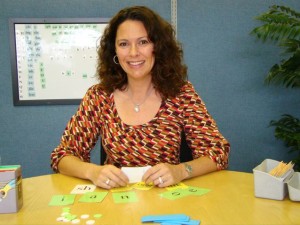
Karina Richland, M.A. is the Founder and Director of PRIDE Learning Centers, located in Los Angeles and Orange County. Ms. Richland is a certified reading and learning disability specialist. Ms. Richland speaks frequently to parents, teachers, and professionals on learning differences, and writes for several journals and publications. You can visit the Pride Learning Center website at: www.pridelearningcenter.com

by PRIDE Reading Program Admin | Apr 12, 2015 | A PRIDE Post, Dyslexia
Parents are always asking me what they can do to help their dyslexic child. My first response is to most importantly get the child into an Orton-Gillingham program that will give them the necessary skills for reading, writing and spelling improvement. This will need to be done by a trained specialist and should be the number one priority for the dyslexic child.
Keep in mind that the trained dyslexia professional is helping your child by doing the difficult work for you. They are doing reading activities and skill training. It won’t necessarily be for fun and pleasure. So, this is the perfect time that you as a parent get to just read together with your child for fun and pleasure. This is what you the parent can do to give your child the dyslexia help at home they need.
Most likely you will be working with your child after school when they are tired and less receptive to learning and when you, too, are not at your most energetic or patient, therefore, I recommend that you read together with your child for at least thirty minutes each evening making it fun and not a chore for either of you. Evenings spent reading together build a lifelong pattern of enjoyment. A child who avoids reading is among those most in need of practice and guidance, and is especially helped by your reading aloud with him.
When reading for pleasure, allow your struggling reader to relax and listen attentively without being expected to read. You should still encourage your child to sit next to you, so he can see the pages of the book as you read. If you are helping your child with a book that must be read for school, encourage your child to participate by taking turns reading; you can ask your child to read a sentence or a paragraph, then read several paragraphs yourself, then let your child have another turn.
In books with a lot of dialogue, another technique for shared reading is to let your child take the role of one (or more) or the characters, reading the quoted words for that character. This is also a good opportunity to help your child focus on punctuation, such as quotation marks, commas, periods, exclamation points, and question marks. Many children with dyslexia do not understand what punctuation means, and they tend to ignore or disregard punctuation marks when reading because they are so focused on trying to decipher the letters and words. With oral reading, punctuation takes on added significance, as it provides information about when the reader should pause and the intonation that should be used.
When your child is reading aloud, do not interrupt to correct mistakes that do not change meaning, such as reading “mom” for “mother.” Frequent interruptions will cause your child to lose confidence and make comprehension more difficult. If your child stumbles over a word, simply tell her what it is. Do not try to use teaching techniques such as having her sound out words at this time. Instead, enjoy the story together, discuss the plot, and praise your child for her efforts when she reads aloud and is able to figure out some words on her own.
Your child may find it helpful to hold an index card or ruler under each line of text as he reads. This will help him stay focused on the text. It is also possible to purchase a reading guide with a colored filter in the center, which is designed so that your child can move it down the page as he reads.
Some children prefer fiction while others prefer nonfiction. By pairing them, your child will be exposed to both genres. Your child will also love discussing these books together with you.
Because a child with dyslexia needs very individualized and specialized reading help, I recommend that parents become the child’s biggest helper. Teaching a child with dyslexia how to read is a complex task, but with a loving touch and good humor, you the parent can most definitely accelerate your child’s progress.
Learn more about the New PRIDE Reading Program
____________________________________________________________________________________

Karina Richland, M.A. is the Founder of PRIDE Learning Centers, located in Los Angeles and Orange County. Ms. Richland is a certified reading and learning disability specialist. Ms. Richland speaks frequently to parents, teachers, and professionals on learning differences, and writes for several journals and publications. You can visit the PRIDE Learning Center website at: www.pridelearningcenter.com
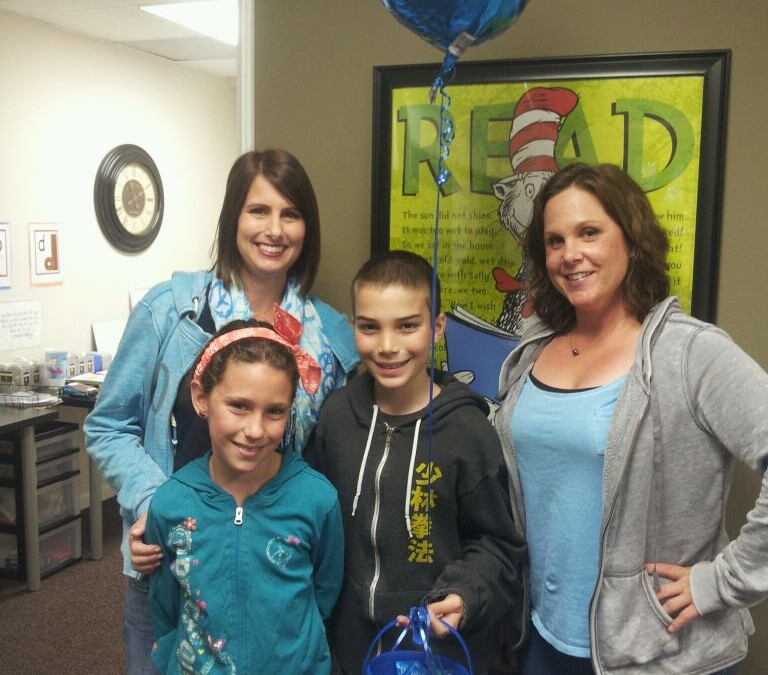
by PRIDE Reading Program Admin | Mar 30, 2015 | Articles & Resources, Autism
PRIDE Learning Center will help raise awareness for autism by participating in the “Light it Up Blue” campaign beginning April 2, 2015.
On April 2, 2015, Autism Speaks, the world’s leading autism advocacy organization, promotes their annual event called Light it Up Blue. This is a global initiative that kicks-off Autism Awareness Month. In honor of this day, many iconic landmarks, hotels, sporting venues, concert halls, museums and retail stores are among the many communities that take part in Light it Up Blue. Autism Speaks is dedicated to funding research into the causes, prevention, treatments and a cure for autism.
PRIDE Learning Center, will help raise awareness by participating in the Light it Up Blue campaign. All four PRIDE Learning Centers will be decorated in blue with displays and handouts about autism on Thursday, April 2, 2014 and there will be blue treats for the entire community. In addition, the employees at PRIDE Learning Center will be dressed in blue.
“We support the Light it Up Blue campaign,” says Karina Richland, owner of PRIDE Learning Centers. “We want to help increase the awareness of Autism Spectrum Disorders and advocate for the needs of individuals with autism and their families” says Richland.
Autism statistics from the U.S Center for Disease Control and Prevention (CDC) identify around 1 in 88 American children as on the autism spectrum. Studies also show that autism is four to five times more common among boys than girls. An estimated 1 out of 54 boys and 1 in 252 girls are diagnosed with autism in the United States.
“We are so pleased and excited to participate in this event to bring autism awareness to the forefront and show that we at PRIDE Learning Center support research efforts to bring an end to this epidemic,” says Richland.
PRIDE Learning Center has four locations in Redondo Beach, Newport Beach, San Clemente and Mission Viejo. For more information visit the PRIDE Learning Center website at www.pridelearningcenter.com or call 866-774-3342.

by PRIDE Reading Program Admin | Mar 30, 2015 | Summer Programs
PRIDE Learning Center, a tutoring center in Yorba Linda, has announced it will offer a specialized summer reading camp to better meet the needs of children with dyslexia, auditory and visual processing, speech delays, autism, ADHD and other language and learning disabilities.
The summer reading camp at PRIDE Learning Center in Yorba Linda will run weekly from June -August to accommodate busy schedules and traveling families. Children can attend from 9:00am – 12:00pm Monday –Friday. All of the teachers at PRIDE Learning Center are credentialed with strong special education backgrounds and deliver one-on-one Orton-Gillingham language and reading lessons.
“This summer reading camp at PRIDE is designed to help students in a way that a regular summer school program cannot,” states Center Director May Dabbah. “Summer is a wonderful and effective time for struggling students to boost their skills and close the reading and comprehension gaps,” says Dabbah.
PRIDE Learning Center is a leading tutoring company in Los Angeles and Orange County, for students with learning disabilities. Their reading and comprehension program has been shown to boost student performance almost 2 grade levels in just 3 months. The Orton-Gillingham instruction develops the underlying reading and comprehension skills necessary for students with dyslexia, auditory processing, visual processing, autism, speech delays, ADHD and other learning challenges. It is common to see years of reading improvement after just weeks of intensive instruction.
“Although the reading camp is intensive and highly structured, the teachers at PRIDE make it really fun and super engaging for the kids. The kids love it and we have families return to us each summer,” says May Dabbah.
PRIDE Learning Center in Yorba Linda is located at 19045 Yorba Linda Blvd in Yorba Linda, Ca 92886.
Individuals interested in the summer reading camp at PRIDE Learning Center in Yorba Linda can call (949) 484-0230 or visit the website at www.pridelearningcenter.com or email info@pridelearningcenter.com.
Page 20 of 35« First«...10...1819202122...30...»Last » 
















